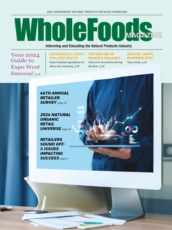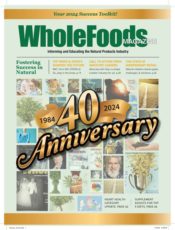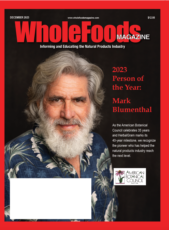Having just returned from the trade show Expo West—that Roman orgy of “natural” food products put on annually at the Anaheim Convention Center—I feel compelled to take on a subject that was very much on my mind as I surveyed the thousands of products on display: the utter BS that you see on labels. Sadly, this includes many “natural” foods and supplements.
Conscious consumers are known to be label readers, which is definitely a good thing and a step in the direction of being more mindful of what we put into our bodies. We read the labels so that we can “know” what’s in the supplements we take and the food we consume. So far, so good.
It’s great to actually read the label, but it’s even better if we can actually evaluate what’s on that label.
This is important. Big Food is amazingly good at grabbing whatever nutritional buzzwords are current at the moment, and then expropriating them to sell more products. Whether there’s a correspondence between what the buzzwords on the label imply (“Now with omega-3!”) and what’s actually in the product is, sadly, quite another matter.
Omega-3s are a great example. Most people now know that “omega-3s” are a good thing, though I’d argue that fewer people could tell you why. Even fewer would know the difference between the three omega-3 fats (alpha-linolenic acid, docosahexaenoic acid, and eicosapentaenoic acid) and their respective effects on the body. And even fewer would have the remotest idea of the correct dose of any of them.
Yet I see everything from candy bars to eggs that proclaim “enriched with omega-3.” And when you investigate more closely, you find that it’s nearly always a plant-based omega-3 (ALA), which is somewhat less potent as an omega-3 than the other two and requires a higher dose to be really effective. (By higher, I mean a tablespoon of flaxseed oil or the like, which would provide about 7 grams of ALA [or 7,000 mg]). Typically the “enriched” products contain less than 50 milligrams per serving which is essentially useless.
Fish oil is another, related product where unscrupulous manufacturers can really go to town. Remember, the only reason we take fish oil is for the omega-3s—fish oil is one of the richest source of the omega-3s EPA and DHA to be found anywhere on the planet. But not all fish oil has the same amount of omega-3s.
Here’s how it works. Remember the old westerns, where old grizzled prospectors would go up into the mountains to prospect for gold? They’d have these tin pans with all these little pebbly rocks in them, but only some of the pebbles were actual gold nuggets. The rest were rocks. Well, it’s kind of the same thing with fish oil. The omega-3s are the gold nuggets carried in the oil. But I’ve seen bottles of commercial fish oil in big box stores where the label proclaims “1,000 mg of fish oil”, yet when you read the nutrition facts label on the back you see there is zero, I repeat, zero omega-3s.
Yes, it’s possible to buy fish oil that does not contain a single mg of omega-3. And that’s totally legal.
Speaking of gold nuggets, let’s talk about resveratrol. I’m a big fan of this nutraceutical, which is found primarily in the skins of dark grapes and in wine. And resveratrol has become a very big-selling supplement due to a lot of research on its anti-aging properties. But what a lot of people don’t know is that the active part of resveratrol—the “gold nuggets” if you will—is a compound called trans-resveratrol.
Trans-resveratrol is the active compound in resveratrol, the only part that’s really important. And not all resveratrol is trans.
If you just read the front of the label—which might typically say “1,000 mg resveratrol” or “500 mg resveratrol” you’d be missing the most important piece of data—how much trans-resveratrol is contained in that dose. More honest manufacturers will tell you, even if it is in the fine print. They’ll say something like “standardized for 20% trans,” or “standardized for 10% trans.”
That means that if you’re holding a 500-mg capsule of resveratrol that’s been standardized for 20% trans, 100 mg of the resveratrol in that capsule is trans-resveratrol. A 250-mg resveratrol capsule, standardized for 20% trans would yield 50 mg of trans-resveratrol. A 600-mg resveratrol capsule, standardized for 10% trans would yield a mere 60 mg of trans.
Remember, you dose only on the trans part. And experts recommend between 250 and 500 mg of trans resveratrol a day. That’s an awful lot of resveratrol capsules if they’re only standardized to 20% or even 30%. One brand family I like a lot is Reserveage and ResVitale because everything in the entire capsule is 100% trans-resveratrol, so when you buy a 500-mg pill, you’re actually getting 500 mg of trans.
Another sub-category of supplement that’s ripe for misrepresentation is grape seed extract. There are some terrific compounds in the seeds of grapes (and pine bark) known as OPCs or oligomeric proanthocyanidins. These are powerful antioxidants in the flavonoid family and they’re the reason that grape seed extract became such a popular supplement.
But, many proathocyanidins are very big molecules which can’t be absorbed by the body. That didn’t stop manufacturers from flooding the market with cheap “grape seed extract” products that were often little more than a bunch of grape seeds that were pulverized in a food processor and contained little of any value. Real OPC products containing just the isolated, smaller, absorbable proanthocyanadins, were much more expensive, and often had a hard time competing with a cheap grape seed extract that “looked” like it was the same thing. (For the record, one excellent commercially available grape seed extract product that actually does contain bioavailable OPCs is Clinical OPC/French Grape Seed Extract by Terry Naturally.)
And finally, there’s turmeric, a superstar in the spice world, largely because it contains bioactive compounds called curcuminoids (or curcumin). But curcumin is not well absorbed, and you’d have to eat a monstorous amount of turmeric to get a clinically meaningful dose of curcumin. That doesn’t stop people from buying cheap “turmeric” capsules that aren’t likely to have much value.
For truly meaningful clinical doses of curcumin, you have to go with high-quality supplements, and even then there’s a great variety in how absorbable they are. I’m a big fan of BCM-95 curcumin, which comes from India, and has been shown in research to be far more absorbable than “garden variety” curcumin. Look for a curcumin supplement that actually says BCM-95 curcumin on the box.
Manufacturers frequently take shortcuts, tell us what we want to hear and misrepresent the health benefits of their products with misleading labels. However, the moral of the story is not, I repeat, not that supplements are worthless.
No, the lesson here is that you should be an educated consumer, armed with as much information as possible. You should shop for supplements wisely, with a skeptical eye towards marketing claims.
Intelligent supplementation is one of the best things you can do for yourself. Just don’t get sucker-punched by misleading labels.
 Jonny Bowden, “the Nutrition Myth Buster”™ is a board-certified nutritionist and the best-selling author of The Great Cholesterol Myth and 13 other books. Visit him at www.jonnybowden.com. Jonny Bowden’s latest book—written with Steven Masley, MD—is called “Smart Fat” and is available now for pre-order on Amazon.
Jonny Bowden, “the Nutrition Myth Buster”™ is a board-certified nutritionist and the best-selling author of The Great Cholesterol Myth and 13 other books. Visit him at www.jonnybowden.com. Jonny Bowden’s latest book—written with Steven Masley, MD—is called “Smart Fat” and is available now for pre-order on Amazon.
Posted on WholeFoods Magazine Online, 3/15/16
NOTE: The statements presented in this column should not be considered medical advice or a way to diagnose or treat any disease or illness. Dietary supplements do not treat, cure or prevent any disease. Always seek the advice of a medical professional before altering your daily dietary regimen. The opinions presented here are those of the writer. WholeFoods Magazine does not endorse any specific company, brand or product.










